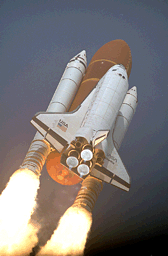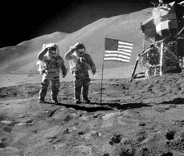 "That is one small step for man, one giant
leap for mankind," Neil Armstrong's famous words that echoed from
the moon. The Apollo program was aimed at landing a man and returning
him back to Earth, but several other goals were also part of the
program these included: to establish technology to meet other national
interests in space, to carry out a program to study the surface of
the moon, to put the United States in the lead of the space race,
and to develop man's ability to work in the lunar environment. The
Apollo spacecraft featured an arsenal of power that came from the
Saturn IB rockets for Earth-orbital flights and the gigantic Saturn
V for the lunar flights. The Apollo spacecraft was broken down into
three man components: the Command Module, the Service Module, and
the Lunar Module. The Command Module (CM) acted as the crew quarters
and flight control section, while the Service Module (SM) provided
the propulsion and support systems with the Lunar Module (LM) was
the two-man ferry that went to the lunar
"That is one small step for man, one giant
leap for mankind," Neil Armstrong's famous words that echoed from
the moon. The Apollo program was aimed at landing a man and returning
him back to Earth, but several other goals were also part of the
program these included: to establish technology to meet other national
interests in space, to carry out a program to study the surface of
the moon, to put the United States in the lead of the space race,
and to develop man's ability to work in the lunar environment. The
Apollo spacecraft featured an arsenal of power that came from the
Saturn IB rockets for Earth-orbital flights and the gigantic Saturn
V for the lunar flights. The Apollo spacecraft was broken down into
three man components: the Command Module, the Service Module, and
the Lunar Module. The Command Module (CM) acted as the crew quarters
and flight control section, while the Service Module (SM) provided
the propulsion and support systems with the Lunar Module (LM) was
the two-man ferry that went to the lunar surface, supported the crew while on the surface, and returned the
crew to the Command and Service Modules (CSM). The Apollo program
is well remember and written in the history books for the famous
landing of Apollo 11 and the first steps of man walking on another
world, but the program did not go along without its terrible and
tragic hardships. On January 27, 1967, the three-man crew of AS-204,
which was scheduled to be the first manned test launch of the Apollo
program, experienced a fire in the Command Module while the were
testing the systems on the pad. This event killed the crew as the
fire quickly engulfed the spacecraft and the crew could not escape
the the deadly smoke. This tragedy crippled the United Space space
program and threaten to end the attempt to put a man on the moon.
About an year later the program started up again, after many improvements
were made to the vehicles, which included mixing the atmosphere and
installing a fast
surface, supported the crew while on the surface, and returned the
crew to the Command and Service Modules (CSM). The Apollo program
is well remember and written in the history books for the famous
landing of Apollo 11 and the first steps of man walking on another
world, but the program did not go along without its terrible and
tragic hardships. On January 27, 1967, the three-man crew of AS-204,
which was scheduled to be the first manned test launch of the Apollo
program, experienced a fire in the Command Module while the were
testing the systems on the pad. This event killed the crew as the
fire quickly engulfed the spacecraft and the crew could not escape
the the deadly smoke. This tragedy crippled the United Space space
program and threaten to end the attempt to put a man on the moon.
About an year later the program started up again, after many improvements
were made to the vehicles, which included mixing the atmosphere and
installing a fast  opening
safety hatch. The crew of Apollo 13 almost saw death as their cryogenic
oxygen tank blew up and spewed all their vital cargo out into the
vast of space and the crew used every resource to get their crippled
spacecraft back to safety on the ground of Earth. Finally on July
20, 1969, Neil Armstrong became the first person to set foot on an
alien world as he climbed out and walked on the lunar surface. In
many ways the Apollo program was the main drama of the decade as
man scrambled to land on the moon and explore another world, while
the other extreme of trying to save a crew that had the cards drawn
against them.
opening
safety hatch. The crew of Apollo 13 almost saw death as their cryogenic
oxygen tank blew up and spewed all their vital cargo out into the
vast of space and the crew used every resource to get their crippled
spacecraft back to safety on the ground of Earth. Finally on July
20, 1969, Neil Armstrong became the first person to set foot on an
alien world as he climbed out and walked on the lunar surface. In
many ways the Apollo program was the main drama of the decade as
man scrambled to land on the moon and explore another world, while
the other extreme of trying to save a crew that had the cards drawn
against them.
Website hosted by Deb Geisler & Mike Benveniste